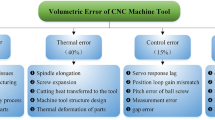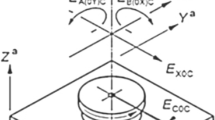Abstract
A tool path generation model with parametric four-bar mechanism was established, and the kinematic geometric coordinate data (tool path) were obtained for crankshaft pin computer numerical control (CNC) grinding. The model was based on the envelope principle; the tool path coordinates were generated by solving a special connecting rod curve. The kinematic performance indexes of crankshaft pin CNC grinding comprise the displacement, velocity, acceleration, jerk in x and y directions, and constant angular speed coefficient. Because of the changes in the parameters, three typical submodels were investigated. It was concluded that the two-axis crankshaft grinding is a special case of in-line slider-crank model. Moreover, a constant angular velocity grinding was achieved using the parallelogram model only. A region was established for the parameters, where the three typical submodels showed the best performance. Finally, the error sensitivity analysis based on the motion error model was carried out using numerical simulation. The results indicate that the three motion errors satisfy the principle of linear superposition, the additional y-axis can be used as error compensation, and the accuracy of rotating spindle C is the most important factor for the high precision of crankshaft pin.
Similar content being viewed by others
References
Tönshoff TK, Friemuth T, Becker JC (2000) Continuous path controlled grinding of crankshaft. Abrasives Mag: 25–29
Hitchiner M, Webster J (2001) Recent advances in camshaft and crankshaft grinding. Abrasive Mag: 7–12
Krajnik P, Drazumeric R, Badger J (2013) Optimization of peripheral cylindrical grinding via an adaptable constant-temperature process. CIRP Ann-Manuf Technol 62:347–350
Drazumeric R, Badger J, Krajnik P (2014) Geometric, kinematical and thermal analyses of cylindrical grinding. J Mater Process Technol 214:818–827
Walsh A, Baliga B, Hodgson P (2004) A study of the crankshaft pin grinding forces. Key Eng Mater 257–258:75–80
Liu YJ, Fan JW, Miao W (2013) Soft compensation for CNC crankshaft grinding machine tool. Adv Mech Eng. doi:10.1155/2013/254709
Huan J, Ma WM (2010) Method for graphically evaluating the workpiece’s contour error in non-circular grinding process. Int J Adv Manuf Technol 46:117–121
Cha KC, Wang N, Liao JY (2013) Stability analysis for the crankshaft grinding machine subjected to a variable-position worktable. Int J Adv Manuf Technol 67:501–516
Oliveira JFG, Silva EJ, Guo C, Hashimoto F (2009) Industrial challenges in grinding. CIRP Ann Manuf Technol 58:663–680
Oliveira JFG, Silva EJ, Gomes JJF, Klocke F, Friedrich D (2005) Analysis of grinding strategies applied to crankshaft manufacturing. Ann CIRP 54(1):269–272
Comley P, Walton I, Jin T, Stephenson DJ (2006) A high material removal rate grinding process for the production of automotive crankshafts. Ann CIRP 55(1):347–350
Denkena B, Gümmer O (2013) Active tailstock for precise alignment of precision forged crankshafts. Procedia CIRP 12:121–126
Wang SL, Lin B, Zhang XF, Liang JM, Wang Y (2015) A novel tool path generation algorithm for plane envelope grinding convex surface based on constant scallop height method. Int J Adv Manuf Technol 78:1087–1099
Fujiwara T, Tsukamoto S, Miyagawa M (2005) Analysis of the grinding mechanism with wheel head oscillating type CNC crankshaft pin grinder. Key Eng Mater 291–292:163–168
Author information
Authors and Affiliations
Corresponding authors
Electronic supplementary material
Below is the link to the electronic supplementary material.
Fig. 14
(JPEG 2414 kb)
Fig. 15
(JPEG 1981 kb)
Fig. 16
(JPEG 3895 kb)
Fig. 17
(JPEG 4053 kb)
Fig. 18
(JPEG 3837 kb)
Fig. 19
(JPEG 2278 kb)
Fig. 20
(JPEG 2075 kb)
Fig. 21
(JPEG 4394 kb)
Fig. 22
(JPEG 2678 kb)
Fig. 23
(JPEG 2293 kb)
ESM 1
(FIG 40 kb)
ESM 2
(FIG 36 kb)
ESM 3
(FIG 40 kb)
ESM 4
(FIG 34 kb)
ESM 5
(FIG 35 kb)
ESM 6
(FIG 584 kb)
(AVI 20840 kb)
(AVI 20840 kb)
(AVI 20840 kb)
(AVI 20840 kb)
(AVI 20840 kb)
(AVI 20840 kb)
(AVI 20840 kb)
(AVI 20840 kb)
(AVI 20840 kb)
(AVI 20840 kb)
(AVI 20840 kb)
(AVI 20840 kb)
(AVI 20840 kb)
Rights and permissions
About this article
Cite this article
Wei, W., Zhang, G. Tool path modeling and error sensitivity analysis of crankshaft pin CNC grinding. Int J Adv Manuf Technol 86, 2485–2502 (2016). https://doi.org/10.1007/s00170-015-8253-1
Received:
Accepted:
Published:
Issue Date:
DOI: https://doi.org/10.1007/s00170-015-8253-1




